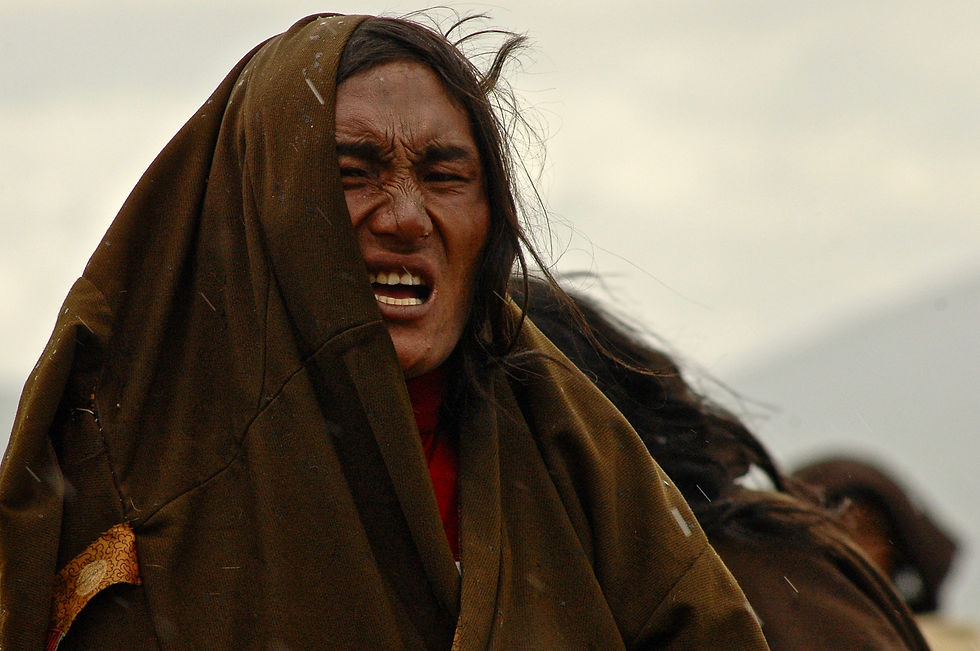Mustang’s Eastern Trade Route
- Jeff Fuchs
- Jun 16, 2017
- 4 min read
Trade routes (still) offer up hints and teasers about how lands evolved and functioned. Everything from DNA to luxuries and tid-bits from the past travelled and each shipment and caravan needed the guardians, the traders and the willful to ensure that the world buzzed. Buddhism itself entered onto the Tibetan Plateau from one of these understated pathways. Nepal’s ancient kingdom of ‘Lo’, known today simply as Mustang, is a place where trade, migration, and pilgrimage routes have long coursed through.

Sun rises on Nilgiri Peak which rests west of Jomsom. Sacred and unclimbed it is another of the great pillars leading into Mustang.
Two years ago while filming the documentary, The Tea Explorer, I had wondered about the vast eastern flank that runs along the Kali Gandaki gorge. It was only now that I was able to return to this vast line of valleys and peaks. Tucked into the sides of disintegrating walls were caves where communities and hermits once resided. The isolation, the vibrance of the high arid earth tones, and the history of trade will always be enough of a draw to rope me in.

Nothing begins, no decision is made and nothing moves without first some tea
Trade and the spirit world fused in a kind of timeless weave in the Himalayas and it was upon the horizontal lines of the mountains (rather than the verticals) that the great journeys were undertaken. Months’ long journeys that took salt, tea, leather, corals, pilgrims, monks….all items and mortals that needed to move or had value, found their way into and onto one of the great spaces of the planet: the Himalayas.

Our group from left to right. Abhu, TJ, Pasang, Subash, Marcus, Keoki, Meli, Jeff, and Julie
For years these routes, whether mere barely visible strands or well marked bits have held me. Their ‘origins’ and their little stops along the way, as well as their ultimate destinations which seemed to change and evolve as time passed have been points of curiosity. Ultimately it was the journeys to trace the routes of tea that drew my attentions and this present journey to Mustang was no different.

Part of a gracefully disintegrating fortress wall in lower Mustang that lies along the trade rout
For every route, there is a tale and there are too, those precious personalities that in some cases remain to fill in some colour of the routes and the lives lived upon them.
This latest journey had the addition of my wife and 4 friends along. They’ve listened to me ramble on about the heights, the culture that resides within, and the addictive grind of ascents. Every single one of these wonderful additions was born at an altitude of less than 100 metres on an island. Hong Kong, Hawaii, Japan, and Guam all featured as birthplaces and as such all have watched as increasing water levels have affected their birthplaces encroaching ever further. I am the single member of the group that wasn’t born on an island. Where we tread in the Himalayas is on the opposite end of this trend of rising water levels. We will wander through villages and corridors that have lost vast amounts of their ice sheets and glaciers. Communities have had to move out of ancient homesteads because seasonal water flows have ebbed, or ceased all-together.

Subash (aka ‘Lion) on right and Abhu who hails from Mustang. Two vital parts of our team who will only get more vital as time passes.
We begin with a meeting with our team of Sherpas (Tibetan: ‘Eastern People’, ‘Sher’ or ‘Shar’ meaning ‘East’ and ‘Pa’ or ‘Ba’ meaning people), Magars (another Tibetan group who reside further east in Nepal and Sikkim), a single ‘Tamang’ who is also of a Himalayan people and a local from Upper Mustang in Nepal. Teams in the mountains either become families in short order, or they simply are helpers. I choose the former and have been so fortunate over time to count many of the mountain teams as friends. They are beacons of so much knowledge and power and they have a kind of fatalistic mirth which I suppose comes with being born amidst the great peaks. “Our blood”, a Sherpa friend of mine likes to remind me “cannot forget where we were born”.

In the days along the trade routes, the lead mule was known as the Sho’drel to Tibetan muleteers. This here is our gem of a lead in full kit. Without such mules the entire caravan could end up in disarray. Still now, they are absolute musts on any journey.
After the meeting of our extended family a blessing in a small dark Nunnery outside Muktinath, by a single nun. The blessing is for safe passage and it soothes and calms and reminds that the bodies don’t simply operate on their own.

Our mule team strung out following the lead mule. Everything we need for the coming three weeks is carried on the backs.
The journey will follow a rough 200 km route whose lines will be spent ascending or descending into gorges and onto ridge lines. We begin it all between the twin snow lines of the 8000+metre Dhaulagiri and Annapurna in the windblown town of Jomsom.

Our own team heads up along a strand of a pathway that reaches up into other worlds
Under Pasang Sherpa’s lead and with a restless mule team we ease out and up.




Comments